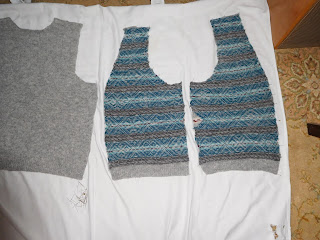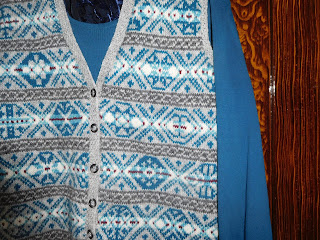I've really enjoyed wearing these waistcoats during the warm October days we've been having. I also enjoy seeing the two of them hanging together like this. It's the colours rather than the patterns, I think.
As I try to explain to non-knitters how I planned the patterns, I can see their eyes glaze as the thought, "You must be mad" passes through. "Planning" is a rather grand term for how I actually did it.
My previous waistcoats have involved two colours only. Here, I was going for the more traditional Fair Isle shading so I chose two background colours and two pattern colours for each one. I was knitting a plain back, so that was one of the background colours sorted. Trying out a little swatch helped me to check that there was sufficient contrast.
Choosing the highlight colour for the middle row was again a question of trial and error. I went for less contrast on the brown version than on the blue.
Then, I needed my trusty Sheila McGregor book of "Traditional Fair Isle Patterns". I had a basic formula in mind, so I looked only at the 17 row patterns for individual lozenges. On the blue I needed more patterns, so I used some 15 row patterns and placed them within the lozenge shape. I invented some, especially where only part of the lozenge was in view.
To start off with, I printed off some knitters' graph paper and copied the patterns for the band on to it in pencil, so I had a complete chart to follow. As I got more used to the rhythm I did not bother doing that and just worked the lozenges from the book.
Of course, making it up as you go along - always my preferred method - does have its drawbacks. Lozenge patterns can be more open, like a grid, or more dense with pattern colour. Ideally these would be placed carefully on the piece to ensure balance. You can see the lack of pattern colour on a lozenge half way up one side quite easily on the reverse of this front which is blocking.
I thought I might top this up with some duplicate stitch, but it is hidden from view at the side, so I did not bother.
Mid-front, though, you can see the imbalance of density in some lozenges. If I were repeating the exercise I would try to correct this.
As I said, most people, certainly most non-knitters, do not subject their clothing to this kind of scrutiny.
So, what's next? In a charity shop last week, my eye was caught by this jumper, in two colours of green, both heathered with those lovely tweedy fibres. I'm thinking of recovering the yarn and using the dark green as the starting point for my next project...

















.JPG)